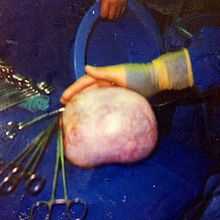Dermoid cyst

A dermoid cyst is a cystic teratoma that contains an array of developmentally mature, solid tissues. It frequently consists of skin, complete with hair follicles, and sweat glands. Other commonly found components include: clumps of long hair, pockets of sebum, blood, fat, bone, nails, teeth, eyes, cartilage, and thyroid tissue.
Because it grows slowly and contains mature tissue, a dermoid cyst is almost always benign. The rare malignant dermoid cyst usually develops squamous cell carcinoma in adults; in infants and children it usually develops an endodermal sinus tumor.[1]:781
Location
A dermoid cyst can occur wherever a teratoma can occur, since they are categorically classified as such.

Ovarian dermoid cysts
Ovaries normally grow cyst-like structures called follicles each month. Once an egg is released from its follicle during ovulation, follicles typically deflate. Sometimes fluid accumulates inside the follicle, forming a simple (containing only fluid) cyst.[2] The majority of these functional cysts resolve spontaneously.
While all ovarian cysts can range in size from very small to quite large, dermoid cysts are not classified as functional cysts. Dermoid cysts originate from totipotential germ cells (which are present at birth) that differentiate abnormally, developing characteristics of mature dermal cells. Complications exist, such as torsion (twisting), rupture, and infection, although their incidence is rare. Dermoid ovarian cysts which are larger or present complications might require removal by either laparoscopy or laparotomy (traditional surgery).[3][4]
Periorbital dermoid cysts
Dermoid cysts can appear in young children, often near the lateral aspect of the eyebrow (right part of the right eyebrow or left part of the left eyebrow). These are sometimes excised and sometimes simply kept under observation, depending on the perceived amount of risk.
An inflammatory reaction can occur if the dermoid cyst is disrupted, and dermoid cysts can recur if not completely excised. Sometimes complete excision is not practical if the cyst is in a dumbbell configuration where it extends through a suture line in the skull.
If the dermoid cysts appear on the medial aspect, the possibility of an encephalocele becomes greater and should be considered among the differential diagnosis.
Spinal dermoid cysts
Spinal dermoid cysts are benign ectopic growths thought to be a consequence of embryology errors during neural tube closure. Their reported incidence is extremely rare, accounting for less than 1% of intramedullary spinal cord tumours. It has been proposed that a possible 180 cases of spinal dermoid tumours have been identified over the past century in the literature.[5][6]
Dermoid cysts more often involve the lumbosacral region than the thoracic vertebrae and are extramedullary presenting in the first decade of life.
Various hypotheses have been advanced to explain the pathogenesis of spinal dermoids, the origin of which may be acquired or congenital.
- Acquired or iatrogenic dermoids may arise from the implantation of epidermal tissue into the subdural space i.e. spinal cutaneous inclusion, during needle puncture (e.g. lumbar puncture) or during surgical procedures on closure of a dysraphic malformation.[6][7]
- Congenital dermoids, however, are thought to arise from cells whose position is correct but which fail to differentiate into the correct cell-type. The long-time held belief was that the inclusion of cutaneous ectodermal cells occurred early in embryonic life, and the displaced pluripotent cells developed into a dermoid lesion.[7][8]
Spinal abnormalities, e.g. intramedullary dermoid cysts may arise more frequently in the lumbosacral region (quite often at the level of the conus medullaris) and may be seen with other congenital anomalies of the spine including posterior spina bifida occulta as identified by the neuroradiological analysis.[5][8]
Treatment
Treatment for dermoid cyst is complete surgical removal, preferably in one piece and without any spillage of cyst contents. Marsupialization, a surgical technique often used to treat pilonidal cyst, is inappropriate for dermoid cyst due to the risk of malignancy.
The association of dermoid cysts with pregnancy has been increasingly reported. They usually present the dilemma of weighing the risks of surgery and anesthesia versus the risks of untreated adnexal mass. Most references state that it is more feasible to treat bilateral dermoid cysts of the ovaries discovered during pregnancy if they grow beyond 6 cm in diameter. This is usually performed through laparotomy or very carefully through laparoscopy and should preferably be done in the second trimester.[9]
Differential diagnosis
A small dermoid cyst on the coccyx can be difficult to distinguish from a pilonidal cyst. This is partly because both can be full of hair. A pilonidal cyst is a pilonidal sinus that is obstructed. Any teratoma near the body surface may develop a sinus or a fistula, or even a cluster of these. Such is the case of Canadian Football League linebacker Tyrone Jones, whose teratoma was discovered when he blew a tooth out of his nose.[10]
See also
- Ovarian cyst
- Cyst
- Dermoid sinus, more commonly known as a pilonidal cyst
- Proliferating trichilemmal cyst
- List of cutaneous conditions
References
- ↑ Freedberg, et al. (2003). Fitzpatrick's Dermatology in General Medicine. (6th ed.). McGraw-Hill. ISBN 0-07-138076-0.
- ↑ "Mayo Clinic: Ovarian Cysts" https://www.mayoclinic.com/health/ovarian-cysts/DS00129/DSECTION=causes
- ↑ "Cyst Management"http://onlinelibrary.wiley.com/doi/10.1002/uog.7610/full#bib2
- ↑ "Dermoid Cyst of the Ovary Defined" http://www.medterms.com/script/main/art.asp?articlekey=2960
- ↑ 5.0 5.1 Najjar et al (2005) Dorsal Intramedullary Dermoids. Neurosurgery Review. 28:320-325
- ↑ 6.0 6.1 Aalst et al (2009) Intraspinal Dermoid and Epidermoid Tumours: Reports of 18 Cases ad Reapproasal of the Literature. Pediatric Neurosurgery. 45:281-290
- ↑ 7.0 7.1 Roth et al (1966) Intramedullary dermoid - Journal of neurology, Neurosurgery and Psychiatry 29:262-264
- ↑ 8.0 8.1 Muraszko et al (2000) Intramedullary spinal tumours of disordered embryogensis – Journal of Neuro-oncology 47:271-281
- ↑ Walid MS, Boddy MG. (2008). "Bilateral dermoid cysts of the ovary in a pregnant woman: case report and review of the literature". Arch Gynecol Obstet. 279 (2): 105–108. doi:10.1007/s00404-008-0695-3. PMID 18509663.
- ↑ Maki: Jones returns to say goodbye Globe and Mail, November 16, 2006
| ||||||||